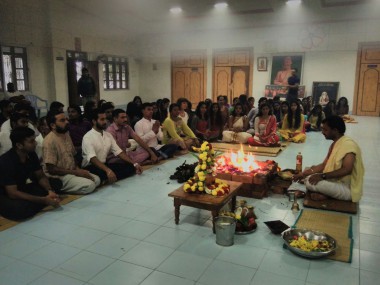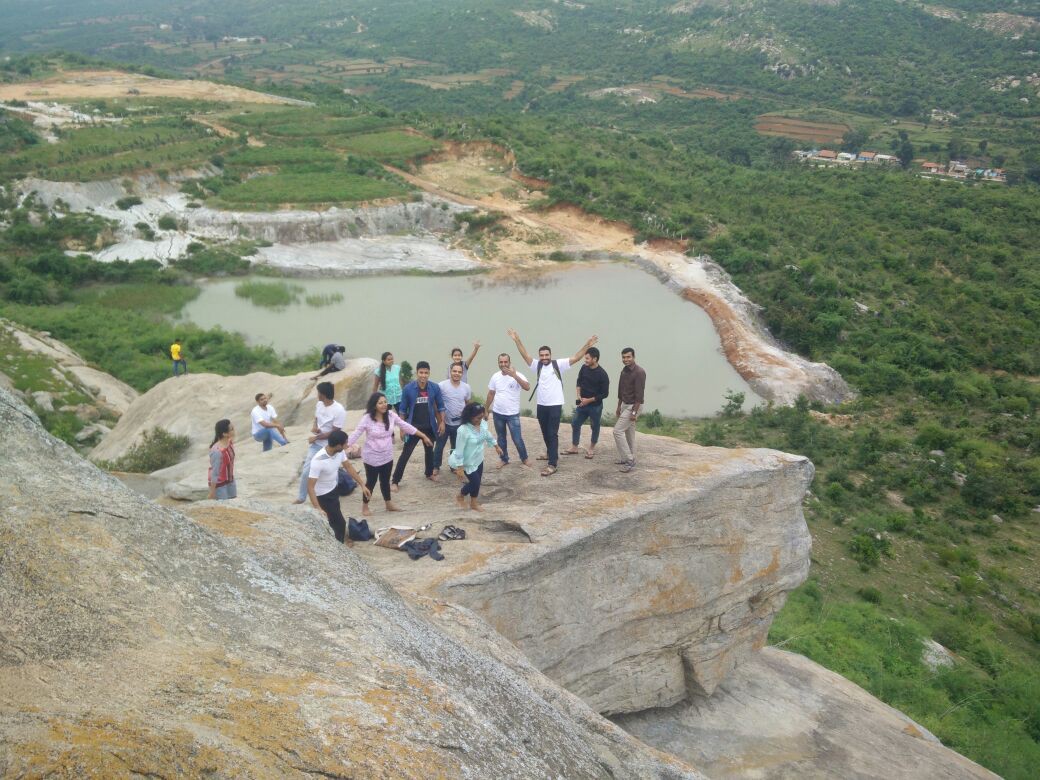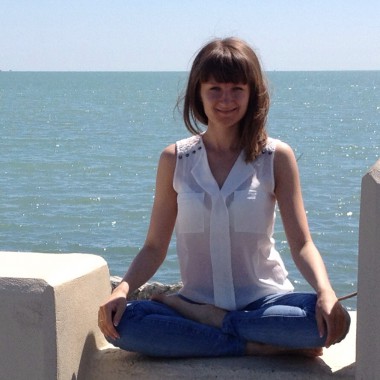What do you usually do after breakfast? For example a few months ago I have been singing Hanuman Chalisa and Bhagavad Gita shlokas for the 30 days, so as other 94 students from YIC Yoga Teachers Course. India, 30 km from Bangalore, Yoga University named after Swami Vivekananda, Prashanti Kutiram campus, September 2016.
Ksenia Belova "Yoga teachers in India: Gurukula in action"


What were my expectations from the one month teachers course in SVYASA? I wanted to try an authentic approach to learning and practicing yoga, plunge into local culture, visit India not as a tourist, but for educational purposes, find new experience and information that I can apply in teaching yoga and my personal practice, adding to my existing knowledge. As it often happens, the reality surpassed all my expectations. There were only two foreign students on our course – me and a girl from Jamaica, who was in fact Indian by origin. All the rest (93 persons aged 19-65) came from all corners of India: from big cities and villages, with completely different professions and life goals, with different experiences in yoga. This made my immersion completely authentic. And the short training course indeed appeared to me a small separate life-piece, filled with knowledge, impressions, achievements and wonderful people who will always remain in my heart.
Swami Vivekananda Yoga Anusandhana Samsthana university was established in 1986. It is primarily an educational institution, as well as an ashram, a research yoga laboratory and a rehabilitation center. Here they adhere to the system of traditional Indian Gurukula training and, at the same time, widely use modern scientific approaches. The mission of the university is to combine the best from the East (yoga and spiritual knowledge) with the best from the West (modern scientific research).
In SVYASA besides one-month course of YIC Yoga Instructor, you can do a bachelor's, master's or doctor's degree in yoga in such fields as naturopathy, yoga therapy, yoga philosophy, ayurveda and even organization and staff management. Depending on the chosen course, training lasts from one month to two years and you also have an option of distance education. By the way, the YIC course is compulsory for admission to any long-term syllabus.

The university includes Anvesana research laboratory that studies the physiological effects of yoga and its therapeutic use, develops new rehabilitation methods and scientifically explains seemingly inexplicable metaphysical practice. Special attention at the university is paid to research on Cyclic meditation (this practice was originally developed there), its application and the influence on humans. In SVYASA there is also a hospital Arogyadhama, that can accommodate 250 people and specializes in treating numerous diseases – from migraine, ulcers and mental disorders to diabetes and cancer, using thoroughly studied methods of yoga, naturopathy and ayurveda. I must say the treatment is quite successful, I remember one example very well. A man with the 4 stage of throat cancer had practically returned to normal life and overcame the disease after one and a half year being in hospital, and during this period he was not subjected to any allopathic remedies.
The campus is a vast green zone, comprising teaching blocks, prayer area, canteen, hospital, laboratory and living blocks. You get used to living in the campus quite fast and many things become unnoticeable. The locals live in large dormitories by 8-12 people, foreigners are lucky enough to have double or triple rooms. But the course price also differs – 910$ for foreigners versus 16 000 rupees for the Indian students. The food is strictly vegetarian, from animal origin products there is only milk. There is a lot of spicy food, but it suited me and I felt great. The housing is really humble but you get used to it quite fast and on the second-third day stop to notice that, and when you come home to your comfortable apartment you really miss it.

Each day our classes began at 5.30, starting with a short practice of pranayama and OM-meditation, followed by asanas class, that was partly methodological – a simple practice, where we were taught what we would teach. Then we had a half an hour for breakfast and at 8:00 o’clock Maitri Millan session began – there we sang Bhagavad Gita shlokas and listened to the head of university’s lectures on quite vital topics. At 9:00 o’clock usually karma yoga began – this month we learned quite well to sweep and wash floors, destroy weeds, make roti and plant coconut palms. Frankly speaking, everything was even more interesting than that. It was a wonderful opportunity to test one’s conscience, as it was quite easy to act the maggot, no one would have noticed. We learned how to disengage oneself from the work you are doing, "be inactive in action" and team-up.

At 10:00 lectures and practical classes began, at 13:00 we had lunch, and at 14:00 or 15:00 again lecture and practical classes. Dinner was at 19:30, and after 20:30 students were to stay in their rooms according to the campus regulations. The classes were diverse: lectures on yoga anatomy, history and philosophy, the life path of Shri Ramakrishna and Swami Vivekananda, we discussed Bhagavat Gita, Patranjali Yoga Sutras, Hatha Yoga Pradipika in detail. We had practical and theoretical classes on teaching methods, Cyclic meditation, Trataka, pranayama and kriyas. There were interesting classes on stress management, the concept of happiness, culture of the mind, team building and psychological games.
Lectures always included mantras and shavasana – it is much more effective for good memorizing the material, and the theory necessarily alternated with practice. In general, everything was unexpectedly intense and interesting, the course program was not really inferior to any of a western-type. But it also had one thing you can never find in any Russian, American or European yoga-course. Yoga education in India is not really a strict system with plans and schemes, but rather a global transformation of the habitual way of life and thinking patterns. Busy schedule, multiple practices, all out-of-the-class activities and the overall atmosphere in complex make a difference. Being in India you feel that yoga cannot be practiced for an hour or two a day, that it is not only asanas or philosophy, that yoga is a way of life.
By the way, we did had a schedule, but nevertheless, we almost never knew what would be our next class. And by the second week my western brain got used to it, and I stopped asking everyone "what class do we have next?". But I didn’t stop wondering how everything manage to work out in such chaos and uncertainty. For example, we found out we have two successive exams 10 minutes before they started. You know, it was great, as we had no time for unnecessary stress.
When we came up to the final exams, practically everyone had the necessary knowledge in their minds, thanks to the “theory-practice” approach, no one was challenged by the exams and everyone received the certificates. But, nevertheless, we had to prepare ourselves and do a lot. All-inclusive theoretical tests, practical examinations in asanas teaching, Cyclic meditation and pranayama (everyone was checked with a stopwatch), an exam on singing bhajan and mantras, defense of the course paper. In addition we had to prepare a final concert with dances, songs, sketches and yoga pyramids. I want especially draw attention to the kriyas exam – together, side by side, we did jala and sutra neti, as well as vamana dhauti. It was really fun and caring teachers eventually taught almost everyone to do it.
In addition to Yoga Instructors Course, we had the opportunity to take a seven-days Yoga Instructors for Diabetes Mellitus course, as well as pass the QCI (Quality Council of India) Level 1 exam, established by the Ministry of AYUSH and the Government of India to standardize and certify the yoga teacher as a profession. Although I didn’t take the first course, more than a half of our students did. The problem of diabetes is quite relevant in India, and SVYASA is doing a great job to amend the situation. But I passed the QCI exam, and it was a very interesting experience! The test was divided into theoretical and practical parts – a board of 5 people from various yoga institutions assessed our personal practice, knowledge of kriyas, benefits and possible traumas we can get performing certain asanas, the contents of basic yoga texts and teaching skills.
We scarcely had any day-offs during the month, so we nearly forgot what is actually a “week day”. Sometimes there was quite a lack of time – it was a luxury to wash our clothes, rest or repeat a lecture. But I had no fatigue, although sometimes my nighttime sleep lasted only 3-4 hours, I had plenty of energy. This was the result of regular Cyclic meditation, pranayama and various relaxation techniques practice, as well as of nutrition, atmosphere and physical activities.

Of course, we didn’t only study during this month. We went on a small trekking to the cliffs with spectacular scenic views, for a whole week we celebrated the Ganesha Festival, we visited various final concerts. It was never boring, especially considering that the Indians are constantly dancing, singing and their lives often resemble an eternal feast. On our final academic day, Saraswati puja was specially organized for us to bless the “new-born” yoga instructors. We also took the opportunity to go for safari to the Bannerghatta park, on our final day we organized a trip to elephants, white tigers and lions.
As the teacher of our course once said: “During the first week many people are lost and unhappy, on the second week they start to get used to everything, on the third they have fun, and on the fourth they cry and don’t want the course to end”. This was the exact thing with us.
Was this course useful for me? Definitely. I can’t say that I found out a lot after having a few teachers-courses in Russia, but some things blended in with my personal practice and with what I will share with my students. In SVYASA, yoga is divided into 4 types: Bhakti, Gnyana, Raja and Karma Yoga and we thoroughly analyzed the concepts of each of them. In asana practice, they follow Patanjali's approach – everything should be done with no effort and could be done by everyone, and the main criterion for yoga pose practice is "Sthiram Sukham Asanam", which means "asana is a comfortable and stable position of the body". Much attention is paid to the sensations after the practice, they use some techniques I never heard of before. I’ve learnt some new warmimg-up and breathing exercises, as well as cardio which set is seamlessly build in practice. Various relaxation techniques, Nada yoga (yoga of the sound), Cyclic meditation – I will definitely continue to practice this.
Besides the teaching process, this month was very useful for my comfort zone extension: singing bhajans and mantras by heart on the stage with a microphone, performing Indian cultural dances at a final concert, participating in closing ceremony speech, final exams. Add to that the adaptation to the culture, unusual for me, new mentality and Indian English. And, you know, all this was not difficult at all, it captivated me thanks to the care of the people who were around me this month.
Each day during the YIC-course I woke up with a feeling of boundless gratitude for this experience, for the opportunity to be there this time. Changes and transformation come at different levels, but I can definitely say that everyone will take something for himself and search inside his personality there, even in such a short period of time. I think in India it doesn’t happen any other way. Certainly, Prashanti Kutiram is not India, but a small stand-alone universe. But my classmates, 94 people from all over India, as well as the teachers and coordinators of the YIC course in this month showed me real India, because this country really is in peoples’ hearts.

Ksenia Belova,
Yoga Therapist & Yoga Teacher,
Vancouver (Canada)
www.facebook.com/yogainvancouver/


